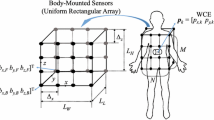Abstract
These years, implant devices has been attracting great attention. Wireless capsule endoscope is one good example of the implant devices. Nowadays, the implant devices are usually used to just examine one’s diseases. However, in the near future, they may be used not only for the examination but also to treatment of a disease. To realize the next generation capsule endoscope, it is strongly required to add location information to the implant device. Such localization techniques enable us to control the movement of the implant device or to improve the treatment efficiency. Localization techniques has been studied widely, which often use radio frequency (RF) signals from the device. When we use this technique, there is a problem that we need a burdensome pre-measurements before the localization. To avoid such a burdensome pre-measurement, we turn our eyes on electromagnetic (EM) imaging which estimates the internal structure of an subject. The imaging can realize an examination without any burdensome pre-measurements, however, the EM imaging with high resolution will need huge computational complexity. To solve the problem, we applied genetic algorithm (GA) into the EM imaging-based localization method. Furthermore, we evaluated the localization performance of the proposed GA-based method compared with the conventional RF-based methods through computer simulations using a simple human body model. In addition, we show a possibility of using the EM imaging as an promising implant device localization method without any burdensome pre-measurement.











Similar content being viewed by others
References
M. R. Yuce and T. Dissanayake, "Easy-to-Swallow wireless telemetry" IEEE Microwave Magazine, Vol. 13, No. 6, pp. 90–101, Sept.-Oct., 2012.
T. Ito, D. Anzai and J. Wang, "Performance evaluation on RSSI-based wireless capsule endoscope location tracking with particle filter," IEICE Trans. Commun., Vol. E97–B, No. 3, pp. 579–586, March, 2014.
D. Anzai, S. Aoyama and J. Wang, "Performance evaluation on RSSI-based localization for capsule endoscopy systems with 400 MHz MICS band signals," IEICE Trans. Commun., Vol. E95–B, No. 10, pp. 3081–3087, Nov., 2014.
M. Kawasaki and R. Kohno, "Position estimation method of medical implanted devices using estimation of propagation velocity inside human body," IEICE Trans. on Commun., Vol. 92, no. 2, pp. 403–409, 2009.
S. Hara, D. Anzai, T. Yabu, K. Lee, T. Derham and R. Zemek, "A perturbation analysis on the performance of TOA and TDOA localization in mixed LOS/NLOS environments," IEEE trans. Commun., Vol. 61, No. 2, pp. 679–689, Feb., 2013.
J. Wang and T. Takagi, "A noninvasive method for dielectric property measurement of biological tissue," IEICE Trans. Commun., vol. E77–B, No. 6, pp. 738–742, June, 1994.
W. Weiyan and Z. Shourong, "Unrelated illumination method for electromagnetic inverse scattering of inhomogeneous lossy dielectric bodies," IEEE trans. Antennas Propagat., Vol. 40, No. 11, pp. 1292–1296, Nov., 1992.
D. Lawrence, Handbook of Genetic Algorithms, New York: Van Nostrand Reinhold, 1991.
Acknowledgements
This study was supported in part by JSPS KAKENHI Grant Number 15K18063 and Strategic Information and Communications R&D Promotion Programme (SCOPE) #145106002.
Author information
Authors and Affiliations
Corresponding author
Rights and permissions
About this article
Cite this article
Iida, T., Anzai, D. & Wang, J. A Three-Dimensional EM-Based Implant Device Localization Method Improved by Genetic Algorithm. Int J Wireless Inf Networks 24, 180–188 (2017). https://doi.org/10.1007/s10776-017-0332-9
Received:
Accepted:
Published:
Issue Date:
DOI: https://doi.org/10.1007/s10776-017-0332-9




